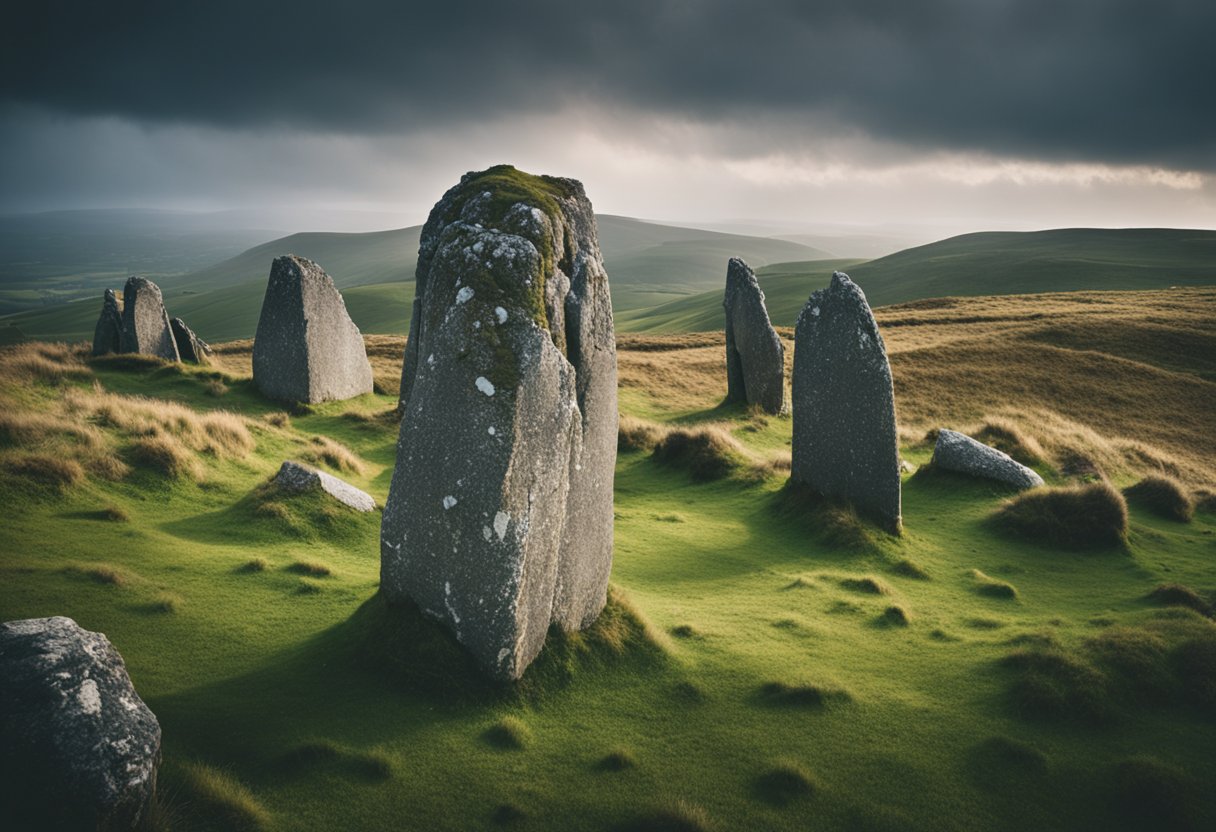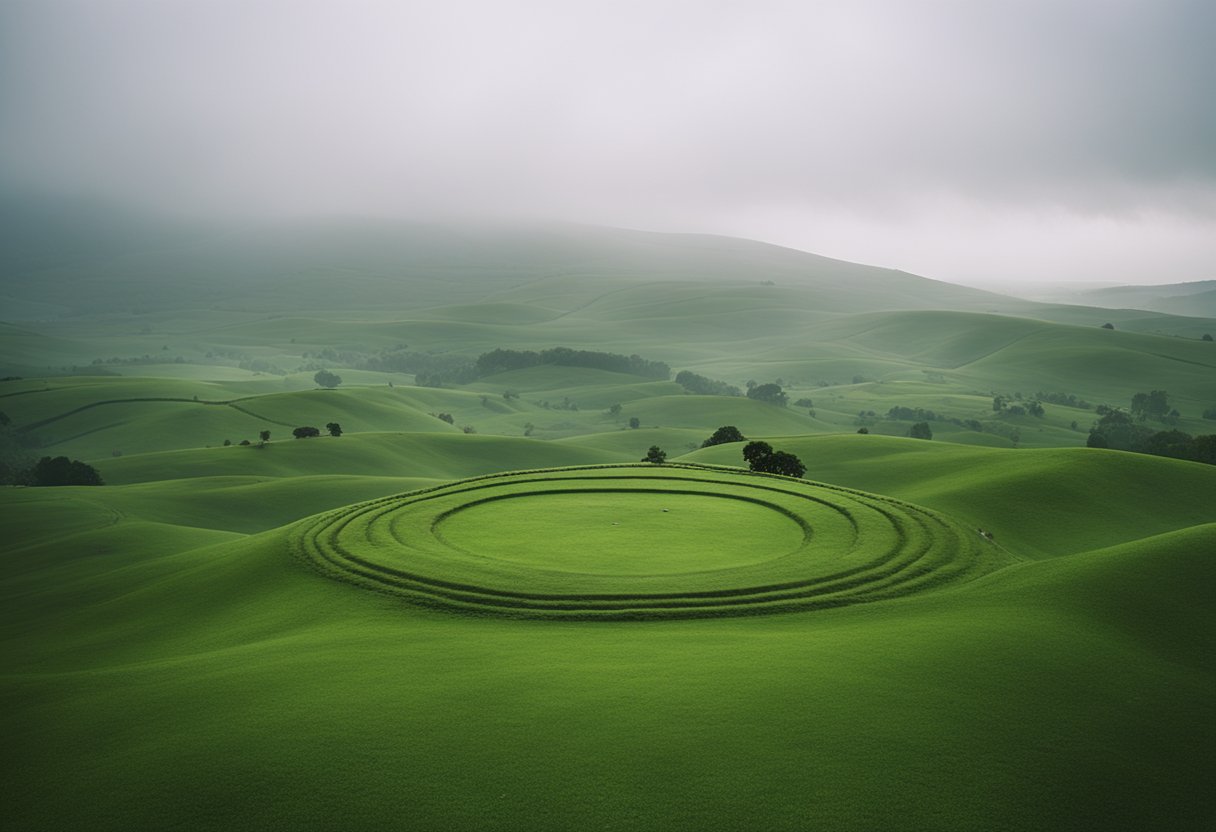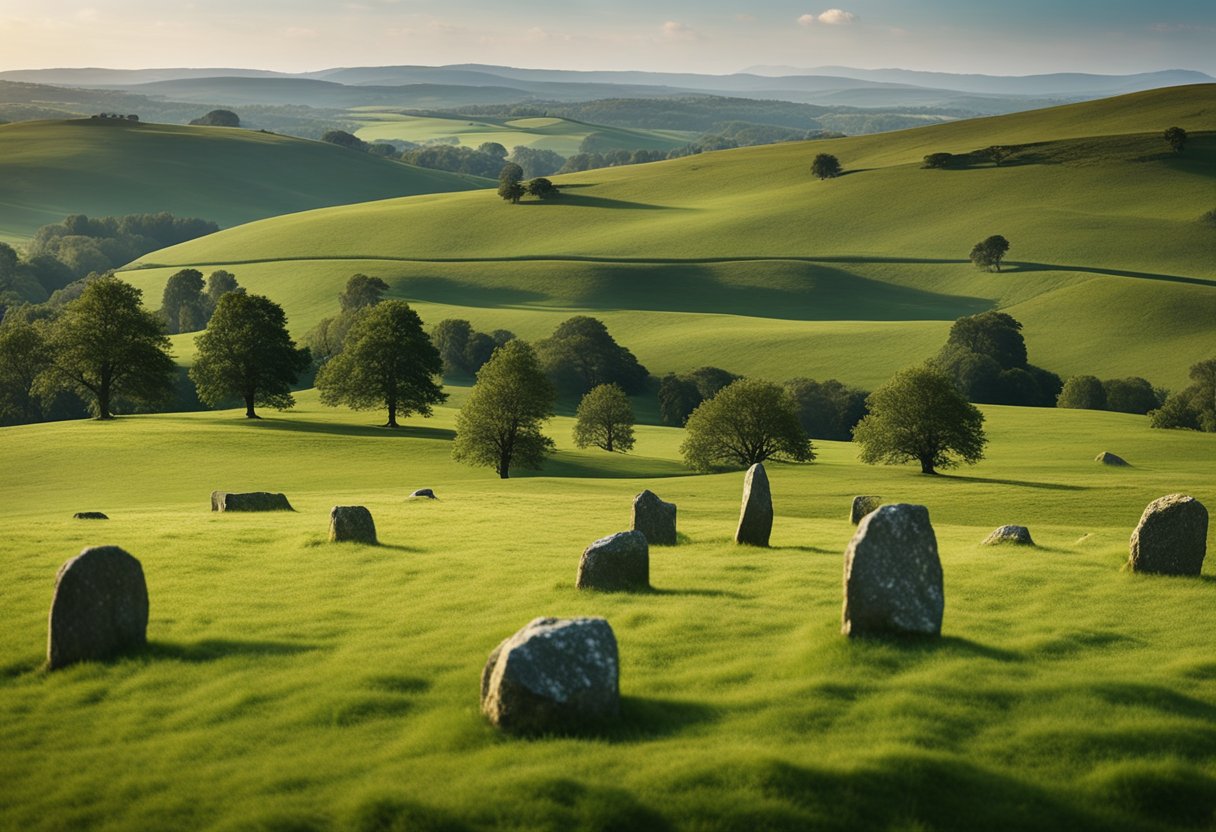Sacred Stones and Ancient Monuments of Ireland: Exploring the Isle’s Enigmatic Heritage

Updated On: April 23, 2024 by Maha Yassin
Ireland’s landscape is embroidered with sacred stones and ancient monuments, connections to a mystical past that has captivated humanity for generations. These structures, silent witnesses to centuries of history, beckon us to uncover the spiritual significance long ascribed to them. From the Neolithic era, the dawn of monument building marked a shift in society and the expression of cosmological understanding and ceremonial practices. Ireland’s stone circles, dolmens, and passage tombs give us a glimpse into a distant time when the cycles of life and death, the celestial patterns, and the seasons governed human existence.
The allure of Ireland’s prehistoric sites extends beyond their historic worth. These monuments, ranging from the renowned Hill of Tara to the enigmatic Drombeg Stone Circle, stand as a testament to the sophistication and scale of early Irish society. Each stone, each ancient alignment reveals a piece of the puzzle in understanding Neolithic engineering and spiritual belief. By exploring these remnants of the past, we come closer to grasping the rich tapestry of beliefs that bound the communities to their sacred land. This exploration converges history, spirituality, and the profound interconnection of Irish stone monuments with those of other Neolithic societies.
The Spiritual Significance of Irish Ancient Monuments
Irish stone monuments, veiled in myths and legends, are a testament to a spiritual heritage that spans millennia. Through ancient beliefs and rituals and the folklore surrounding the Earth goddess Ériu, these monuments connect us to Ireland’s mystical past.
Ancient Beliefs and Rituals
Our ancestors intricately linked their lives to the land, most evident in the stone monuments punctuating the Irish landscape. Sites such as the renowned Drombeg Stone Circle, referred to as the Druid’s Altar, were focal points for ceremonial practices aligned with celestial events. Astrological alignments found in stone circles were not mere coincidences; they were purposeful, positioning the stones about the movements of the sun, the moon, or certain stars. The ancient Irish were attuned to the land and the sky, seeking a harmonious existence with the forces they deemed sacred.
Folklore and the Earth Goddess Ériu
The embodiment of Ireland itself is found in the deity Ériu, the Earth goddess from whom we get the name Éire. Legends tell of Ériu as a symbol of the land’s sovereignty and spirituality, a sacred figure who, along with her sisters Banba and Fódla, were part of the Tuatha Dé Danann, the ancient deities of pre-Christian Ireland. Monuments such as standing stones and burial mounds were not merely stone and Earth; they were intimately connected with the heritage and spiritual energy of the land. The lore of Ériu weaves through Ireland’s sacred sites as a reminder of our ancestors’ reverence for the Earth and its deities.
Neolithic Ireland and the Dawn of Monument Building
In the Neolithic period, Ireland saw the emergence of monumental stone structures and the profound shift from a nomadic lifestyle to settled farming communities.
Megalithic Tombs and Cairns
We find evidence of the Neolithic people’s complex spiritual and social lives in the enduring megalithic tombs and cairns they left behind. The most renowned passage tomb at Newgrange was constructed around 3200 BCE. This imposing structure is part of a larger complex of tombs, which includes Knowth and Dowth, collectively known as Brú na Bóinne. Such tombs typically feature a large circular mound with a stone passageway leading to a central burial chamber. The precise alignment of these tombs with astronomical events, such as the winter solstice sunrise at Newgrange, underscores the Neolithic people’s sophistication in astronomy and construction.
The Advent of Agriculture and Settlements
The transition to a settled way of life was marked by the introduction of agriculture, a pivotal development in Neolithic Ireland. Culturing crops and the domestication of animals provided a stable food source, which allowed for the growth of permanent settlements. This newfound stability paved the way for constructing large communal structures and fostered social cohesion. From this secure base, the Neolithic communities could invest time and resources into creating their monumental stone edifices, reflecting a connected society deeply woven into the tapestry of the natural and the spiritual worlds.
Iconic Sites of Prehistoric Significance
Ireland’s landscape is steeped in history and mystique, with ancient stones and prehistoric monuments offering a window into a long past. We will explore some of the most astonishing prehistoric sites that continue to captivate scholars and visitors alike.
Newgrange and the Boyne Valley
The Boyne Valley is home to Newgrange, a UNESCO World Heritage site and one of Europe’s most renowned prehistoric monuments. Newgrange, built over 5,000 years ago, predates Stonehenge and the Great Pyramids of Giza. This passage tomb is famed for its winter solstice illumination when sunlight penetrates its passage and chamber at sunrise. Archaeological evidence suggests that the structure held ceremonial significance for the pre-Christian societies that built it.
The Mysterious Loughcrew Complex
Loughcrew, in County Meath, is another significant prehistoric site. This complex Neolithic passage tomb dates back to approximately 3,300 BCE. The area is often called Ireland’s ‘Hill of the Witch’ due to its numerous cairns and megalithic structures dotting its landscape. Enigmatic symbols carved into the stones within these tombs remain a subject of debate and fascination, hinting at Ireland’s pre-Christian rituals and cosmology.
The Sacred Geometry and Alignment of Ancient Monuments
Irish ancient monuments are masterpieces of sacred geometry and precise astronomical alignment. These structures are physical testimonies to our ancestors’ sophisticated understanding of the cosmos and the natural world.
Astronomical Significance of Passage Tombs
Newgrange, perhaps the most famous of Ireland’s passage tombs, showcases a profound connection with the celestial calendar. Its entrance is meticulously aligned to allow the sun’s rays to illuminate its inner chamber during the winter solstice. This event highlights the importance of cyclical astronomical observations to those who built these monuments thousands of years ago.
Enigmatic Alignments and Their Meaning
Loughcrew, another remarkable passage tomb complex, aligns with the winter solstice and the autumn equinox. During these pivotal times of the year, the sunlight interacts with the carvings inside the tombs, revealing intricate patterns that can be interpreted as forms of an ancient calendar. These alignments and siting choices reflect our forebearers’ desire to mark the passage of time and seasons, rooting their spiritual and daily lives within the greater cosmological cycle.
Exploring the Rich Tapestry of Ireland’s Megalithic Landscape
We are about to journey through Ireland’s fascinating megalithic landscape, a testament to its ancient past where stones tell stories millennia-old, and regions reveal the breadth of megalithic practice.
The Diverse Regions of Megalithic Activity
Ireland’s megalithic monuments are not randomly sprinkled across the landscape; they are richly woven into the regions with a dense concentration in the northwest. County Sligo, in particular, stands out with its many sites.
- Carrowmore: Home to one of the largest collections of megalithic tombs, offering a profound glimpse into Neolithic Ireland.
- Carrownaglogh: Here lies a group of monuments displaying diverse megalithic art and structural sophistication.
Visitors to these regions find themselves enveloped in the ambience of Ireland’s ancient history, with each stone structure marking a page of Ireland’s mystical tale.
The Role of Natural Elements in Monument Placement
Megalithic architects of ancient Ireland selected their monument locations with respect for the natural world that bordered on the sacred. The alignment of many tombs with celestial events – solstices and equinoxes – highlights a sophisticated understanding of their environment.
Viewing these monuments against the backdrop of Ireland’s natural elements makes the harmonious relationship between placement and landscape apparent. From the rolling hills of Sligo to the jagged coastline, the interactions with the environment suggest a deep connectedness to and reverence for the land these ancient people called home. Their respect for the island’s natural beauty still resonates through time, urging us to contemplate our place within the wider web of life.
The Cultural Heritage and Continuity of Sacred Sites

Ireland’s ancient sacred sites are profound testaments to the island’s long-standing spiritual and cultural practices. These places of worship and ceremony bridge our modern lives with the lives of our ancestors, embodying continuity and preserving heritage.
Hill of Tara: A Ceremonial Centre Through Ages
Tara, known in the Irish language as Teamhair na Rí, has been a crucial ceremonial centre throughout the ages. Our connections to this storied place date back to the Neolithic period, with the gripping Mound of the Hostages as a poignant symbol of this era’s ritual significance. This passage tomb, believed to be over 5,000 years old, reveals our ancestors’ sophisticated understanding of solar events as it’s aligned with the rising sun of Samhain (November) and Imbolc (February).
Continuing archaeological excavations on Tara are invaluable, showcasing a tradition of ceremonial usage that endured for millennia. These findings demonstrate that the site’s significance continued well into the subsequent Iron Age and up to the high-kingship era—symbolising the seat of power and the sacred embodiment of the Irish nation.
Preservation and Ongoing Excavations
Our commitment as keepers of Tara’s legacy involves protective measures for existing structures and contributions to ongoing archaeological research. Excavations have not only uncovered the physical remnants of past societies, such as ceremonial relics and layout alterations, but also serve to enhance our understanding of Tara as a living heritage site. By maintaining the careful balance of preservation and exploration, we ensure that the cultural continuum of Tara’s sacred heritage remains unbroken. Through this vigilant stewardship, these historic monuments remain eloquent narrators of the rich tapestry of Ireland’s cultural history.
Archaeological Discoveries and Insights
In our quest to unravel the enigmatic past of Ireland’s landscapes, recent archaeological developments have provided substantial insights into its prehistoric era.
Remarkable Finds and Their Interpretations
We’ve observed that each discovery, from ancient pottery remains to monumental stones, has painted a more vivid picture of life and rituals from the millennia past. Excavations have shed light on prehistoric Ireland, revealing ritual sites and domestic tools belonging to its early inhabitants. These artefacts, buried for centuries, speak of a time steeped in mystery and tradition. Ground-breaking tools like LIDAR and geophysical surveys have unveiled archaeologists’ findings in unprecedented detail. These finds are not just objects; instead, they are keys unlocking the stories of people from a distant, foggy epoch.
The Cutting-edge Methods in Archaeology
Employing state-of-the-art technology, our archaeologists have explored beneath the surface without disturbing it. Methods like 3D imaging and remote sensing have become instrumental in revealing hidden structures and artefacts with minimal intrusion. These innovative approaches have also assisted conservation efforts, ensuring our shared heritage remains intact for future generations. Through these modern lenses, we can experience the echoes of ancient Ireland as closely as possible and how they were first crafted and used.
The Evolution of Irish Stone Monuments Through History
Irish stone monuments provide a narrative of cultural and religious transformations, spanning from the Neolithic period to the arrival of Christianity. They capture the essence of Ireland’s ancient civilisations and their shifting beliefs.
From Neolithic Cairns to Iron Age Ring Forts
The earliest stone monuments in Ireland emerged with the Neolithic period, where burials and rituals gave rise to impressive cairns and passage tombs like the world-renowned Newgrange. These prehistoric sites are markers of death, astronomical precision, and social complexities.
With the onset of the Iron Age, ring forts began to dot the landscape. These structures, usually circular with towering earthen or stone walls, served as fortified homesteads and places of refuge, a profound evolution from the communal to the more defensively individual.
Christianity’s Influence on Prehistoric Sites
As Christianity spread across Ireland, it left indelible marks on pre-Christian sacred sites. Many stone monuments, including high crosses and round towers, were erected within these ancient ceremonial spaces, integrating old and new beliefs. The High Crosses at monastic sites display intricate biblical carvings, testifying to the union of faith and artistry in the early Christian era. These monuments signalled a shift in the landscape from the mystical to the theological, retaining the sacredness of these sites for successive generations.
Planning Your Visit to Ireland’s Mystical Sites

Embarking on a tour of Ireland’s mystical sites connects you with the ancient past and promises an adventure through some of the most breathtaking landscapes. Let us guide you through crafting a memorable journey and share essential travel tips for your visit.
Constructing a Journey Through Time
When mapping out your itinerary, prioritise sites with a history of spiritual significance, like the Drombeg Stone Circle in County Cork, often referred to as “the Druid’s Altar”. Include a mix of tourism giants such as the passage tombs of the Boyne Valley, namely the Great Mound at Knowth, which radiates a younger aura than its famous neighbour Newgrange. Ensure that your journey spans the well-trodden paths and the more secluded sanctuaries Ireland offers.
- Day 1-3: Start with Dublin’s storied streets before heading to the Boyne Valley.
- Day 4-5: Journey west to the spiritual heart of Ireland in County Mayo.
- Day 6-7: Explore the rugged beauty and standing stones of County Cork.
Travel Tips: Accommodation and Weather Readiness
It’s wise to book well in advance for accommodation, especially near popular sites such as the Rock of Cashel. Consider a mixture of cosy bed-and-breakfasts and countryside inns to immerse yourselves fully in Irish hospitality.
Weather in Ireland can be unpredictable. Packaging for all eventualities is essential – bring layers and waterproof clothing to remain comfortable and ready for your outdoor adventures. Keep a sturdy pair of boots on hand to navigate the often soggy terrain.
- What to Pack:
- Waterproof jacket and trousers
- Layers for warmth
- Comfortable waterproof footwear
- Sunscreen and a hat for the occasional sunny day
Interconnection With Other Neolithic Societies

The Neolithic megasites of Ireland stand not in isolation but as part of a grand tapestry woven across the British Isles and into Continental Europe, prominently showcased in regions like Brittany. These ancient monuments reflect a network of shared practices and beliefs, revealing an intricate pattern of cultural exchange.
Links to British and Continental Megalithic Traditions
Our research indicates that the megalithic complexes across Ireland reveal striking similarities to those found in Britain and Brittany. For instance, the use of impressive stone circles was a common feature that echoes the societal importance of such structures in Neolithic times. These circles often align with astronomical events, suggesting a widespread understanding of celestial phenomena.
Furthermore, the passage tombs in Ireland, resembling the architectural style of megalithic sites found in Britain, point towards a connection beyond mere coincidence. Evidence indicates that these ancient societies were in contact and perhaps exchanged architectural ideas and methods, demonstrating their capability to share and implement complex construction designs over long distances.
Comparing Artistic Expressions Across Regions
One can observe a compelling comparison when examining the artistic expressions found at Neolithic sites throughout Ireland, Britain, and Brittany. Carvings and engravings, which often feature spiral motifs and geometric patterns, testify to a shared visual language that permeated these regions.
This artistic similarity suggests exchanging cultural ideas and motifs, a dialogue that reveals a cohesive Neolithic megalithic tradition. These symbols held significance across vast geographical expanses, which might have played a role in these communities’ spiritual or social activities.
FAQs
We’ve compiled some of the most commonly asked questions about the enigmatic standing stones and ancient monuments that pepper Ireland’s lush landscape, each harbouring centuries of mystique and history.
Which ancient stones in Ireland are considered the most significant?
Some of Ireland’s most significant ancient stones include the Lia Fáil at the Hill of Tara, believed to roar when touched by the rightful king of Ireland, and the Gallarus Oratory in County Kerry, a fine example of dry-stone construction.
How were standing stones traditionally used in ancient Ireland?
Traditionally, standing stones in ancient Ireland were used for various purposes, from ceremonial and ritualistic functions to marking burial grounds. They may also have served as territorial boundaries or had astronomical alignments.
What is the most renowned stone circle in Ireland?
Ireland’s most renowned stone circle is the Drombeg Stone Circle in County Cork, known as the Druid’s Altar. This well-preserved recumbent stone circle is composed of seventeen closely-spaced stones.
Can you provide a map of stone circles found in Ireland?
While we cannot provide a physical map here, one can find maps and databases online that detail the locations of stone circles in Ireland, pinpointing the many sites across the country.
What type of stone is indigenous to Ireland and featured in its ancient monuments?
Indigenous to Ireland and featured in its ancient monuments is the enduring and versatile sandstone and limestone, both prevalent in the construction of many historical sites such as the imposing Newgrange passage tomb.
What are the implications behind the standing stones in Ireland?
The implications behind the standing stones in Ireland often suggest usage for ritualistic or ceremonial purposes, possibly relating to astronomy, as some align with solar and lunar events. Other theories propose they were commemorative or territorial markers.






